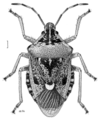
Hemiptera is an order of insects, commonly called true bugs, comprising over 80,000 species within groups such as the cicadas, aphids, planthoppers, leafhoppers, bed bugs, and shield bugs. They range in size from 1 mm (0.04 in) to around 15 cm (6 in), and share a common arrangement of sucking mouthparts. The name "true bugs" is often limited to the suborder Heteroptera. Many insects commonly known as "bugs", especially in American English, belong to other orders; for example, the lovebug is a fly and the May bug and ladybug are beetles.

Elasmucha grisea, common name parent bug, is a species of shield bugs or stink bugs belonging to the family Acanthosomatidae. The term parent bugs includes also the other species of the genus Elasmucha and some species of the family Acanthosomatidae.

Scutelleridae is a family of true bugs. They are commonly known as jewel bugs or metallic shield bugs due to their often brilliant coloration. They are also known as shield-backed bugs due to the enlargement of the thoracic scutellum into a continuous shield over the abdomen and wings. This latter characteristic distinguishes them from most other families within Heteroptera, and may lead to misidentification as a beetle rather than a bug. These insects feed on plant juices from a variety of different species, including some commercial crops. Closely related to stink bugs, they may also produce an offensive odour when disturbed. There are around 450 species worldwide.

The brown marmorated stink bug is an insect in the family Pentatomidae, native to China, Japan, Korea and other Asian regions. In September 1998 it was collected in Allentown, Pennsylvania, where it is believed to have been accidentally introduced. The nymphs and adults of the brown marmorated stink bug feed on over 100 species of plants, including many agricultural crops, and by 2010–11 had become a season-long pest in orchards in the Eastern United States. In 2010, in the Mid-Atlantic United States, $37 million in apple crops were lost, and some stone fruit growers lost more than 90% of their crops. It is now established in many parts of North America, and has recently become established in Europe and South America.

Rhaphigaster nebulosa, common name mottled shieldbug, is a species of stink bugs in the family Pentatomidae. It is the only species of the genus Rhaphigaster.

Picromerus bidens, the spiny shieldbug or spiked shieldbug, is a carnivorous species of shield bug in the family Pentatomidae.
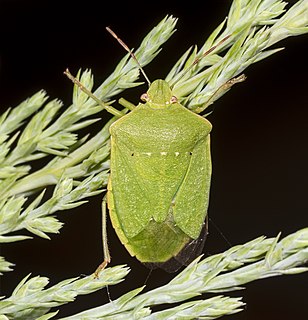
Nezara viridula, commonly known as the southern green stink bug (USA), southern green shield bug (UK) or green vegetable bug, is a plant-feeding stink bug. Believed to have originated in Ethiopia, it can now be found around the world. Because of its preference for certain species of legumes, such as beans and soybeans, it is an economically important pest on such crops.
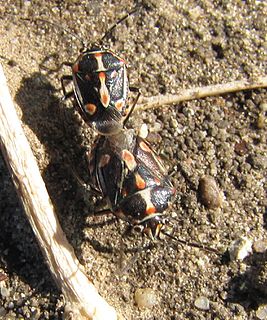
Bagrada hilaris is a species of shield bug known by the common names bagrada bug and painted bug (See a short video at YouTube). It could be mistaken for or erroneously referred to as harlequin bug. It is native to Africa. It is known elsewhere as an introduced species, including California and Arizona, where it was first reported in 2008. It is a major pest insect of Brassica oleracea crops, and related crucifers such as turnips, rape, and mustard. The adult and nymph of the species suck sap from the leaves of the plants, causing wilting, yellowing, and stunting of growth. Besides crucifers, the bugs are known on papaya, sorghum, maize, potato, cotton, caper, pearl millet, and some legumes. Large numbers of the bug congregate on the plants and cause extensive damage.

Apodiphus amygdali is a species of shield bug belonging to the family Pentatomidae, subfamily Pentatominae.

Carpocoris purpureipennis is a species of shield bug of the family Pentatomidae, subfamily Pentatominae.
Stagonomus venustissimus, common name woundwort shieldbug, is a species of shieldbug belonging to the family Pentatomidae, subfamily Pentatominae.

Tessaratomidae is a family of true bugs. It contains about 240 species of large bugs divided into 3 subfamilies and 56 genera.

Euthyrhynchus floridanus, the Florida predatory stink bug, is a species of carnivorous shield bug in the family Pentatomidae, the only species in the genus Euthyrhynchus. It is native to the hottest parts of the southeastern United States and is considered beneficial because it feeds on many species of pest insects. They also feed on things such as grasshoppers and other small insects. This species also hunts in a pack, with up to twelve.
Deraeocoris brevis is a species of predatory plant bug in the family Miridae. It is native to North America where it feeds on plant pests in apple and pear orchards.
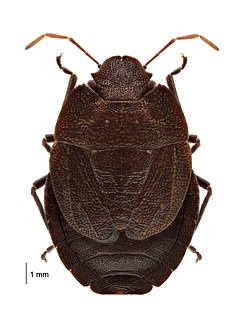
Hypsithocus hudsonae, sometimes called the alpine shield bug or black alpine shield bug, is a species of flightless shield bug endemic to New Zealand. Few specimens have ever been collected and these have come from a relatively narrow geographical range. The New Zealand Department of Conservation classifies this species as 'At Risk,' with qualifiers 'data poor' and 'range restricted.'

Monteithiella humeralis, commonly known as the pittosporum shield bug is a species of herbivorous shield bug native to Australia and introduced in New Zealand. As its common name suggests, it is most commonly observed feeding on Pittosporum plants.
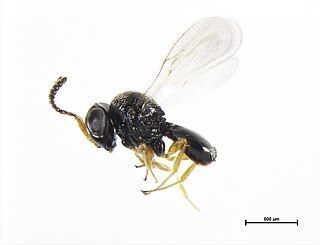
Trissolcus basalis, or the green vegetable bug egg parasitoid, is a parasitoid wasp in the family Platygastridae known primarily for parasitising the horticultural pest Nezara viridula, the green vegetable bug.
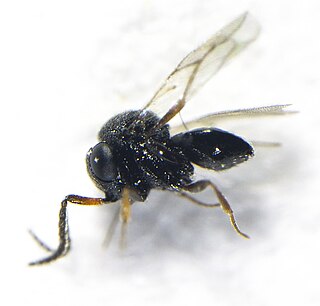
Trissolcus oenone is a parasitoid wasp in the family Platygastridae, native to Australia and New Zealand. It parasitises the eggs of stink bugs (Pentatomidae), but little is known about its biology.

Dictyotus caenosus, commonly known as the brown shield bug, is an Australian species of stink bug that has been introduced into New Zealand and New Caledonia.

Cuspicona simplex, commonly known as the green potato bug, is a herbivorous species of stink bug native to Australia and introduced to New Zealand. It feeds on nightshades, and is primarily known as a pest of potatoes, tomatoes, and other crops in the nightshade family.


